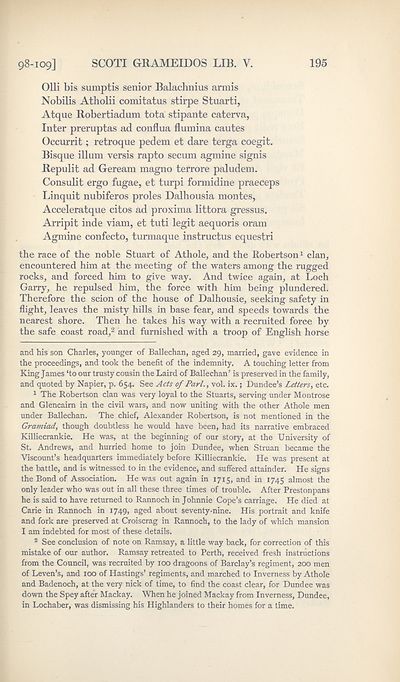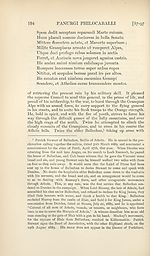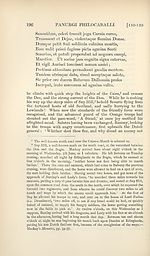Series 1 > Grameid: an heroic poem descriptive of the campaign of Viscount Dundee in 1689, and other pieces
(266) Page 195
Download files
Complete book:
Individual page:
Thumbnail gallery: Grid view | List view

SCOTI GRAMEIDOS LIB. V.
195
98-109]
Olli bis sumptis senior Balachnius armis
Nobilis Atholii comitatus stirpe Stuarti,
Atque Robertiadum tota stipante caterva,
Inter preruptas ad conflua flumina cautes
Occurrit; retroque pedem et dare terga coegit.
Bisque ilium versis rapto secum agmine signis
Repulit ad Geream magno terrore paludem.
Consulit ergo fugae, et turpi formidine praeceps
Linquit nubiferos proles Dalhousia montes,
Acceleratque citos ad proxima littora gressus.
Arripit inde viam, et tuti legit aequoris oram
Agmine confecto, turmaque instructus equestri
the race of the noble Stuart of Athole, and the Robertson1 clan,
encountered him at the meeting of the waters among the rugged
rocks, and forced him to give way. And twice again, at Loch
Garry, he repulsed him, the force with him being plundered.
Therefore the scion of the house of Dalhousie, seeking safety in
flight, leaves the misty hills in base fear, and speeds towards the
nearest shore. Then he takes his way with a recruited force by
the safe coast road,2 and furnished with a troop of English horse
and his son Charles, younger of Ballechan, aged 29, married, gave evidence in
the proceedings, and took the benefit of the indemnity. A touching letter from
King James ‘to our trusty cousin the Laird of Ballechan’ is preserved in the family,
and quoted by Napier, p. 654. See Acts of Pari., vol. ix.; Dundee’s Letters, etc.
1 The Robertson clan was very loyal to the Stuarts, serving under Montrose
and Glencairn in the civil wars, and now uniting with the other Athole men
under Ballechan. The chief, Alexander Robertson, is not mentioned in the
Gramiad, though doubtless he would have been, had its narrative embraced
Killiecrankie. He was, at the beginning of our story, at the University of
St. Andrews, and hurried home to join Dundee, when Struan became the
Viscount’s headquarters immediately before Killiecrankie. He was present at
the battle, and is witnessed to in the evidence, and suffered attainder. He signs
the Bond of Association. He was out again in 1715, and in 1745 almost the
only leader who was out in all these three times of trouble. After Prestonpans
he is said to have returned to Rannoch in Johnnie Cope’s carriage. He died at
Carie in Rannoch in 1749, aged about seventy-nine. His portrait and knife
and fork are preserved at Croiscrag in Rannoch, to the lady of which mansion
I am indebted for most of these details.
2 See conclusion of note on Ramsay, a little way back, for correction of this
mistake of our author. Ramsay retreated to Perth, received fresh instructions
from the Council, was recruited by 100 dragoons of Barclay’s regiment, 200 men
of Leven’s, and 100 of Hastings’ regiments, and marched to Inverness by Athole
and Badenoch, at the very nick of time, to find the coast clear, for Dundee was
down the Spey after Mackay. When he joined Mackay from Inverness, Dundee,
in Lochaber, was dismissing his Highlanders to their homes for a time.
195
98-109]
Olli bis sumptis senior Balachnius armis
Nobilis Atholii comitatus stirpe Stuarti,
Atque Robertiadum tota stipante caterva,
Inter preruptas ad conflua flumina cautes
Occurrit; retroque pedem et dare terga coegit.
Bisque ilium versis rapto secum agmine signis
Repulit ad Geream magno terrore paludem.
Consulit ergo fugae, et turpi formidine praeceps
Linquit nubiferos proles Dalhousia montes,
Acceleratque citos ad proxima littora gressus.
Arripit inde viam, et tuti legit aequoris oram
Agmine confecto, turmaque instructus equestri
the race of the noble Stuart of Athole, and the Robertson1 clan,
encountered him at the meeting of the waters among the rugged
rocks, and forced him to give way. And twice again, at Loch
Garry, he repulsed him, the force with him being plundered.
Therefore the scion of the house of Dalhousie, seeking safety in
flight, leaves the misty hills in base fear, and speeds towards the
nearest shore. Then he takes his way with a recruited force by
the safe coast road,2 and furnished with a troop of English horse
and his son Charles, younger of Ballechan, aged 29, married, gave evidence in
the proceedings, and took the benefit of the indemnity. A touching letter from
King James ‘to our trusty cousin the Laird of Ballechan’ is preserved in the family,
and quoted by Napier, p. 654. See Acts of Pari., vol. ix.; Dundee’s Letters, etc.
1 The Robertson clan was very loyal to the Stuarts, serving under Montrose
and Glencairn in the civil wars, and now uniting with the other Athole men
under Ballechan. The chief, Alexander Robertson, is not mentioned in the
Gramiad, though doubtless he would have been, had its narrative embraced
Killiecrankie. He was, at the beginning of our story, at the University of
St. Andrews, and hurried home to join Dundee, when Struan became the
Viscount’s headquarters immediately before Killiecrankie. He was present at
the battle, and is witnessed to in the evidence, and suffered attainder. He signs
the Bond of Association. He was out again in 1715, and in 1745 almost the
only leader who was out in all these three times of trouble. After Prestonpans
he is said to have returned to Rannoch in Johnnie Cope’s carriage. He died at
Carie in Rannoch in 1749, aged about seventy-nine. His portrait and knife
and fork are preserved at Croiscrag in Rannoch, to the lady of which mansion
I am indebted for most of these details.
2 See conclusion of note on Ramsay, a little way back, for correction of this
mistake of our author. Ramsay retreated to Perth, received fresh instructions
from the Council, was recruited by 100 dragoons of Barclay’s regiment, 200 men
of Leven’s, and 100 of Hastings’ regiments, and marched to Inverness by Athole
and Badenoch, at the very nick of time, to find the coast clear, for Dundee was
down the Spey after Mackay. When he joined Mackay from Inverness, Dundee,
in Lochaber, was dismissing his Highlanders to their homes for a time.
Set display mode to:
![]() Universal Viewer |
Universal Viewer | ![]() Mirador |
Large image | Transcription
Mirador |
Large image | Transcription
Images and transcriptions on this page, including medium image downloads, may be used under the Creative Commons Attribution 4.0 International Licence unless otherwise stated. ![]()
| Scottish History Society volumes > Series 1 > Grameid: an heroic poem descriptive of the campaign of Viscount Dundee in 1689, and other pieces > (266) Page 195 |
|---|
| Permanent URL | https://digital.nls.uk/126598749 |
|---|
| Attribution and copyright: |
|
|---|
| Description | Over 180 volumes, published by the Scottish History Society, containing original sources on Scotland's history and people. With a wide range of subjects, the books collectively cover all periods from the 12th to 20th centuries, and reflect changing trends in Scottish history. Sources are accompanied by scholarly interpretation, references and bibliographies. Volumes are usually published annually, and more digitised volumes will be added as they become available. |
|---|


